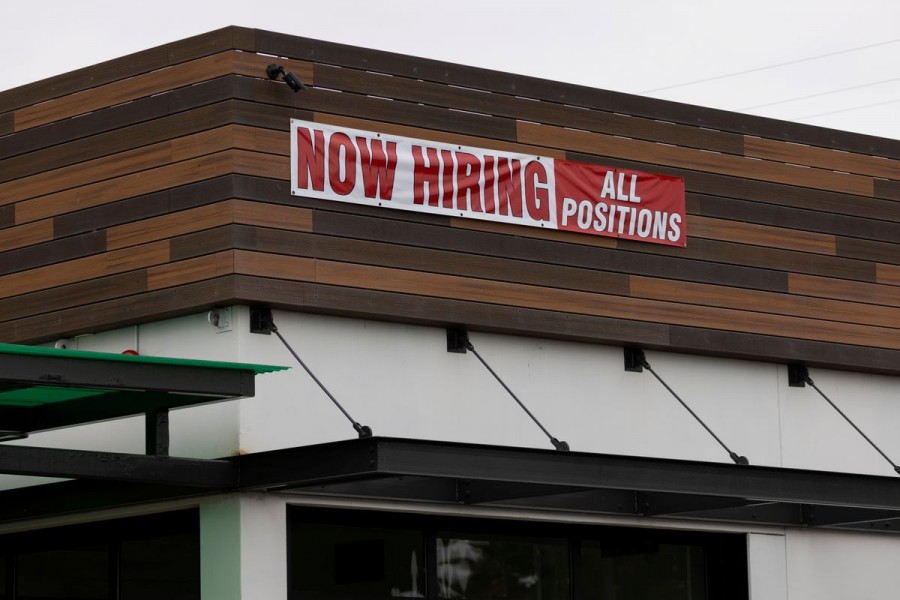US job openings raced to a new record high in July while layoffs rose moderately, suggesting last month's sharp slowdown in hiring was due to employers being unable to find workers rather than weak demand for labor.
The Labor Department's monthly Job Openings and Labor Turnover Survey, or JOLTS report, on Wednesday also showed a steady increase in the number of workers voluntarily quitting their jobs, a sign of confidence in the labor market.
"This is a super tight job market," said Jennifer Lee, a senior economist at BMO Capital Markets in Toronto. "The ongoing struggle to find the right worker for the right role continues."
Job openings, a measure of labor demand, jumped 749,000 to 10.9 million on the last day of July, the highest level since the series began in December 2000. It was the fifth straight month that job openings, which have been increasing since January, hit a record high.
Economists polled by Reuters had forecast vacancies rising to 10 million. July's broad increase was led by the healthcare and social assistance, finance and insurance, and accommodation and food services industries.
Job openings rose in the Northeast, South, Midwest and West regions. The job openings rate surged to a record 6.9 per cent from 6.5 per cent in June, driven by medium-sized businesses with 50-249 workers. The rate for large firms with 5,000 or more employees fell.
Hiring slipped 160,000 to 6.7 million, pulled down by decreases in retail trade, durable goods manufacturing and educational services. State and local government education hiring increased, as did federal government employment.
The hiring rate fell to 4.5 per cent from 4.7 per cent in June. The hires rate dropped for large businesses.
Stocks on Wall Street fell. The dollar rose against a basket of currencies. US Treasury prices were higher.

JOLTS
Tight Labour Market
The job openings to hires ratio, a measure of labor market tightness and companies' ability to find workers, rose to 1.64 in July. The JOLTS data followed in the wake of a government report last Friday that showed nonfarm payrolls increased by only 235,000 jobs in August, the smallest gain since January, after surging by 1.053 million in July.
Labor market tightness was underscored by the Federal Reserve's Beige Book report on Wednesday, based on information collected on or before Aug 30, which showed "all Districts noted extensive labor shortages that were constraining employment and, in many cases, impeding business activity."
The Covid-19 pandemic has upended labor market dynamics, creating worker shortages even as 8.4 million people are officially unemployed.
Lack of affordable childcare, fears of contracting the coronavirus, generous unemployment benefits funded by the federal government as well as pandemic-related retirements and career changes have been blamed for the disconnect.
The labor crunch is expected to ease starting in September, with the government-funded unemployment benefits having expired on Monday. The new school year is underway and most school districts are offering in-person learning.
But soaring Covid-19 cases, driven by the Delta variant of the coronavirus, could cause reluctance among some people to return to the labor force. Employment is 5.3 million jobs below its peak in February 2020.
"While we expect the labor market will continue to make some progress in coming months, it will likely take some time for these severe labor imbalances to get resolved," said Lydia Boussour, lead US economist at Oxford Economics in New York.
The JOLTS report also showed 107,000 people voluntarily quit their jobs in July, lifting the total to 4.0 million. That reflected increases in the wholesale trade as well as state and local government education areas.

Reuters Graphics
There were decreases in the number of people quitting in the transportation, warehousing, utilities and federal government categories. Though the overall quits rate was unchanged at 2.7 per cent, the rate for the private sector - a leading indicator of wage growth - increased to 3.1 per cent from 3.0 per cent.
The quits rate is viewed by policymakers and economists as a measure of job market confidence, and July's rise in the private rate suggested further wage gains, which could keep inflation high for a while. Annual wage growth topped 4 per ceny in August.
Some economists said labor market tightness could put pressure on the Fed to announce when it would start scaling back its massive monthly bond-buying program. Fed Chair Jerome Powell last month affirmed the ongoing economic recovery, but offered no signal on when the US central bank plans to cut its asset purchases beyond saying it could be "this year."
"It takes two to tango and the problem with job creation would appear to be a reluctance to supply labor, not a diminishment of demand, and we would love to hear the economic theory that explains how continued Fed bond purchases encourage workers to return to work," said Conrad DeQuadros, a senior economic advisor at Brean Capital in New York.
Layoffs and discharges rose a modest 105,000 to 1.5 million. That lifted the layoffs rate to 1.0 per cent from 0.9 per cent in June. There were 83 unemployed workers for every 100 job openings in July.
"Even if demand slows down or even falters, job seekers remain in a relatively favorable bargaining position," said Nick Bunker, director of research at Indeed Hiring Lab.


